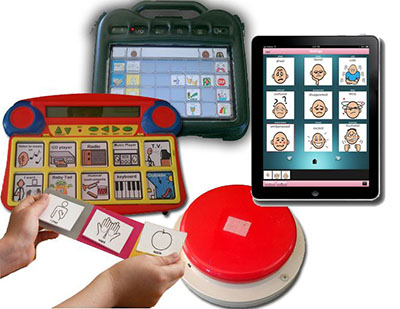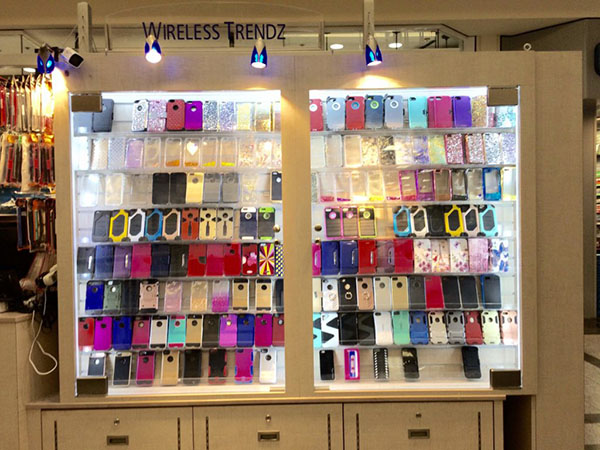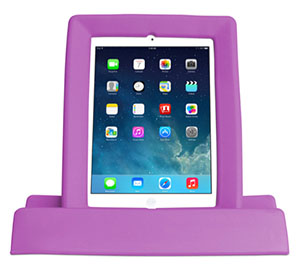Editor’s Note: This is the third post in the series on Disabling Technologies
When I try to explain augmentative and alternative communication (AAC) devices to those unfamiliar, I usually start with physicist Stephen Hawking, who has amyotrophic lateral sclerosis (ALS). Hawking speaks using a high-tech computerized AAC device with synthetic speech output (Mialet, 2012). The electronic voice communicates to others the text that Hawking selects from a cursor moving across the computer screen mounted to his wheelchair using his cheek movement as input.
These sorts of ‘tools for talking’ are also used by those with other disabilities and medical conditions that potentially impair oral speech such as autism, cerebral palsy, or a stroke. AAC devices are mobile by definition, as they ought to move with a person as they move through the world (Reno, 2012). They are becoming more “mobile” in another sense too. Individuals increasingly have the option of using AAC devices that take the material form of ordinary smartphones, tablet computers, and mobile apps that simulate software on specialized computers dedicated to AAC (Alper, 2015).

Variety of augmentative and alternative systems for communication (AAC), ranging from paper to computer-based. Photo Credit: urTalker.
In the tradition of rich ethnographic research on mobile users (e.g., Ito, Matsuda, & Okabe, 2005; Horst & Miller, 2006), I’ve been studying the role that these particular communication technologies play in the everyday lives of those for whom these devices are ordinary (Alper, 2017). What I’ve found is the following: Personalization and ownership radically transform these standardized and medicalized objects in unexpected ways, and this has significant implications for inclusive, person-centered design for all.
Making a Good Case for Mobile Cases
Ownership is integral to how people use (and do not use) mobile devices across their social and communicative contexts, and is therefore highly relevant to design. Although it is individuals with significant speech impairments who use mobile AAC systems, the ownership arrangements for these rather personal and personalized computers are not necessarily straightforward. From 2012-2014, my fieldwork focused on twenty children with developmental disabilities and significant speech impairments in Southern California who use Apple iPads and an app called Proloquo2Go as their AAC system. Some of the families that I spent time with bought their iPads using earned income or grants from nonprofit agencies, while the child’s school or school district also paid in certain instances. Sometimes, one party (e.g., parents) owned the iPad and the other (e.g., the school) owned the protective case for the iPad.

A “Wireless Trendz” kiosk in Boston’s Prudential Center Mall, displaying a colorful array of cell phone cases. Photo Credit: Meryl Alper.
Cases are small objects that made a big impact on use and non-use. Global and local industries thrive around the production and distribution of such mobile accessories, including selfie sticks, portable phone chargers, and smartwatch bands. If you are scrolling through this post on a smartphone or tablet right now, chances are that it is your own private device, and that you have chosen a case for your device that suits your needs and perhaps reflects your personality (or maybe you have chosen to go case-less altogether). Phone and tablet computer cases, though a ubiquitous accessory among the mobile media-using populace, remain largely overlooked by social scientists of technology and design. The empirical research that does exist suggests that mobile accessories primarily function as status markers and personal fashion statements (Hjorth, 2005; Katz & Sugiyama, 2006). These are, however, only a few ways of thinking about the use and non-use of mobile cases.
I was initially surprised by how much parents had to say about their child’s iPad cases, both unprompted and when asked directly about them. In fact, over the course of 16 months of home observations and interviews, it became difficult to fully understand what the iPad meant to families without also asking them to share what they thought about the iPad’s case, as it evoked multilayered and sometimes-conflicting meanings. The case—an object which most people take for granted—unexpectedly raised numerous questions in disability contexts regarding values in design, the nature of “personhood,” and power dynamics in sociotechnical systems.
Beatriz: A Case Study
Ten-year-old Beatriz initially had the thick rubber, bubble-gum-pink-colored Big Grips case pictured below on her iPad. When I first interviewed her father, David, he told me the case was “helping a lot because several times she has dropped the iPad, and it just bounces. It never breaks!” He also liked the pink case “because it was thick but it was easy to grab.” When I first met Beatriz at a meetup group for children who u se AAC devices at a local disability resource center, she was hugging the enlarged iPad like a cherished stuffed animal as she walked into the building’s lobby. Although Beatriz seemingly loved the case, it was her school who had bought and selected it for her. David, an immigrant from Mexico, was happy with what they had chosen, though the process was not transparent to him. “I try to find more,” he said of the Big Grips case, “but I cannot find. I don’t know where they bought it.” It was not even clear why the school had thought the case was the most appropriate for Beatriz in the first place.

The same pink iPad case as used by Beatriz. Photo Credit: Big Grips.
When I interviewed David at home a year later though, I noticed that Beatriz’ pink case was gone, replaced with a black nylon one. Again, the school district’s decision was opaque. In fact, no one made David or Beatriz aware they would even be replacing it, at least not that David could recall. What was apparent, however, was that the school had not taken her design preferences or her personality into consideration.
The new black case made communication even more difficult for Beatriz, who has cerebral palsy and epilepsy. For example, David demonstrated for me how once the cover on the new iPad case was lifted, revealing the screen, there was no Velcro or magnet to keep it open for Beatriz to easily access the screen. The case, it seemed, was designed to stay closed. “For the protection of the device, it’s nice,” David explained, “but for daily use, I don’t think [so].” He also believed that the bland design of the black case directly impacted Beatriz’ desire to use the iPad for communication. Unlike the pink encased iPad, Beatriz displayed no great affection for it when shrouded in black. David noted, “Probably, this has to do with encouragement to use it or not use it, the way [the case is] designed.”
The design of the black iPad case also represented the school district’s skewed values and priorities. David observed, “They put more importance on the protection of the device than on the use of it.” Sure, the black case kept the fragile screen covered, but it would also remain protected as long as Beatriz felt discouraged from even using it. Besides functionally encasing the communication device, the black case symbolically communicated something about Beatriz too—or rather, miscommunicated. To David, based on their selection, the school district had wrongly presumed incompetence on the part of Beatriz. In a sense, the new case for the talking machine itself spoke volumes about the school’s preconceived notions of Beatriz as less than capable. It said, “She’s careless, beware now, she’s going to drop it, she’s going to break it,” David remarked. He demonstrated an anthropological instinct, linking the ways in which Beatriz’ school thought about her disability, and therefore governed her use of technology, with the school’s lack of thought into ramifications of the design differences between the black and pink iPad cases.
Implications for Design
Understanding these linkages between what cases communicate, what preconceptions underlie the choice of cases, and how they influence practices of use, is an “implication for design.” David’s reflection on Beatriz’ cases doesn’t bear much resemblance to an engineer or technologist’s notion of an implication for design, but he masterfully articulates the process by which institutions are implicated in the “long tail” of a design’s execution. Both the pink and black iPad cases are designed to protect but, importantly, the pink case did so in a way that elicited positive interpretations of care and emotion from Beatriz that afforded an intimate bond between her and her communication device.
Ironically, Beatriz cared a lot about the aesthetics of mobile device covers more generally too. As I was discussing the new black case with David in the living room, Beatriz went into her bedroom and brought back a clear, hard plastic pencil case full of rubber iPod Touch and iPhone cases. “Look!” she said orally as she opened the case to show her mom. David turned to me and clarified, “She has this tendency of collecting. She has an obsession for covers.” “Look, look! One … two … three!” exclaimed Beatriz, as she handed them one-by-one to her mother. Cases are a low-cost toy for Beatriz, David said. “We get them, but we try to get the cheapest,” he explained, referring to the family’s financial constraints. I asked if Beatriz ever put them on the family’s mobile devices. “She has. Probably instead of playing dolls, she plays dress-up iPad,” he reflected. How unfortunate, then, that Beatriz’s school-owned tablet was clothed in the equivalent of a drab school uniform.
The story of Beatriz and her family provides a snapshot of how assemblages of power and networks of human relations shape technology, design, and disability. Implications for design encompass the material aspects of information and communication technologies, as well as the socially constructed meanings generated through media and technology use and non-use (Wajcman & Jones, 2012).
These implications extend beyond the borders of the technological device to include the accessories designed to fit them. But “fit” is an elusive and fluid concept. Making sense of how people perceive mobile devices therefore requires a consideration for the ways they are encased, unencased, and reencased. For Beatriz and her family, cases have their own complex social meanings and assigned values in relation to and independent from the devices themselves. Furthermore, these meanings and values are partly informed by individuals’ relationships to the cultural and social institutions shaping the use of encased devices.

My recent book, Giving Voice: Mobile Communication, Disability, and Inequality. Courtesy of MIT Press.
Such associations can be even more precarious and significant for individuals with disabilities, and those who also live at the intersection of other marginalized identities. How do different definitions and delineations of competence and personhood, whether they be self-defined or imposed by other people and institutions, shape the design of personal computers, technology policies, and other sociotechnical systems?
What Beatriz and her family can show us is that cultural anthropology can contribute to design thinking by offering a richer understanding of mobile communication (which pervades all aspects of modern life) and through broadening dominant definitions of “mobile users.” This includes reconsidering who counts as a user (is it an individual or family, and/or an institution), what counts as use (is it purely function or are dressing up iPads, hugging them, and even dropping them also a part of use), and that which we call a mobile device (can it include the case too). Disability, I argue, can illuminate new perspectives on each of these reconsiderations, as well as reveal new design possibilities.
References
Alper, M. (2015). Augmentative, alternative, and assistive: Reimagining the history of mobile computing and disability. IEEE Annals of the History of Computing, 37(1), 93-96.
Alper, M. (2017). Giving voice: Mobile communication, disability, and inequality. Cambridge, MA: MIT Press.
Hjorth, L. (2005). Odours of mobility: Mobile phones and Japanese cute culture in the Asia-Pacific. Journal of Intercultural Studies, 26(4), 39-55.
Horst, H. A., & Miller, D. (2006). The cell phone: An anthropology of communication. New York: Berg.
Ito, M., Okabe, D., & Matsuda, M. (Eds.). (2005). Personal, portable, pedestrian: Mobile phones in Japanese life. Cambridge, MA: MIT Press.
Katz., J. E., & Sugiyama, S. (2006). Mobile phones as fashion statements: Evidence from student surveys in the US and Japan. New Media & Society, 8(2), 321-337.
Mialet, H. (2012). Hawking incorporated: Stephen Hawking and the anthropology of the knowing subject. Chicago: University of Chicago Press.
Reno, J. (2012). Technically speaking: On equipping and evaluating “unnatural” language learners. American Anthropologist, 114(3), 406-419.

1 Trackback